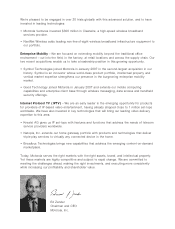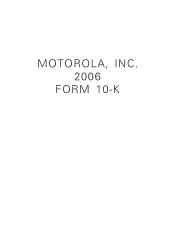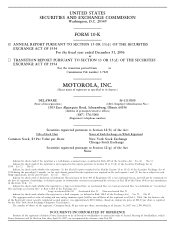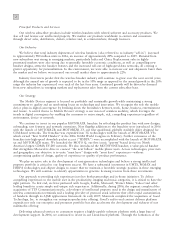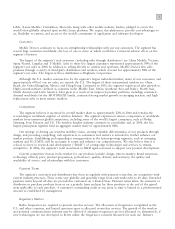Motorola 2006 Annual Report Download - page 14
Download and view the complete annual report
Please find page 14 of the 2006 Motorola annual report below. You can navigate through the pages in the report by either clicking on the pages listed below, or by using the keyword search tool below to find specific information within the annual report.
6
Our Industry
We participate in multiple global markets within the mobile segment of the communications industry,
providing wireless equipment and services to public carriers and other wireless service providers, as well as public
safety, government and enterprise customers.
Within our public networks market, we primarily provide radio access cellular infrastructure systems. This
market grew approximately 5% in 2006, compared to 10% in 2005 and we expect this market to experience flat to
low single digit growth in 2007. We are also an early leader in the emerging market for next-generation wireless
broadband networks, including WiMAX technology.
The majority of installed cellular infrastructure systems are based upon CDMA, GSM, UMTS and iDEN
technologies. We supply systems based on each of these technologies and are the sole supplier of proprietary iDEN
networks. Advanced infrastructure systems based on these technologies include GPRS, CDMA-1X and EDGE. In
addition, some segments of the cellular infrastructure industry have installed, or are in the process of migrating to,
third-generation (""3G'') networks, which are high-capacity radio access wireless networks providing enhanced data
services, improved Internet access and increased voice capacity. The primary 3G technologies are W-CDMA (based
on either UMTS or Freedom of Mobile Multimedia Access (""FOMA'') technologies) and CDMA2000 1xEVDO.
An additional 3G technology standard is TD-SCDMA, driven primarily by the Chinese government and local
Chinese vendors. We now expect 3G licenses to be awarded in China during 2008. We supply systems based on
UMTS and CDMA 2000 1xEVDO technologies. Advanced infrastructure systems based on 3G technologies include
high-speed downlink packet access (""HSDPA'') and high-speed uplink packet access (""HSUPA''). Commercial
service of 3G technologies was first introduced in Asia and has expanded to Western Europe and North America.
Industry standards bodies are in the process of defining the next generation of wireless broadband systems after
3G. The Institute of Electrical and Electronics Engineers (""IEEE'') is currently developing fixed and mobile
broadband standards (802.16d and 802.16e) based on orthogonal frequency division multiplexing (""OFDM'')
technology, which offer systems performance utilizing wider channels enabling triple play services (voice, data,
video). Based upon developments in the 802.16e standard, we expect to see the WiMAX market begin to
materialize in 2008 as several WiMAX networks come on-line and devices utilizing these networks become widely
available. We are an early leader in next-generation wireless broadband products, including WiMAX technology.
The International Telecommunications Union (""ITU'') is also developing next-generation cellular wireless
access standards (""4G'') for the cellular infrastructure industry, also anticipated to be based upon OFDM
technology.
Within our private networks business, homeland security remains an important issue at the local, state and
national levels. We expect this industry to grow in the mid-to-high single digit percentage range in 2007, consistent
with industry growth in 2006. We provide solutions for each of the major standards based private network
technologies, APCO (Association for Public Safety Communications Officials) 25 and TETRA (terrestrial trunked
radio). We expect product sales to continue to grow worldwide as demand for intersystem, interoperable public
safety communications grows. As both technologies mature, better frequency utilization has increased the demand
and potential for data applications and we expect to see increased demand for data-based products in 2007 and
beyond.
In addition, Motorola recognizes a significant market opportunity in the next several years as enterprises
increase their deployment of mobile technologies. The enterprise markets in which Motorola competes include
enterprise wireless infrastructure, mobile computing solutions, bar code scanning, radio frequency identification
(""RFID'') solutions and mobile management platforms. Organizations that are looking to increase productivity and
derive benefits from mobilizing their applications and workforce are driving the enterprise mobility market. We
expect the overall enterprise mobility market to grow in the high single digits in 2007. With the completion of the
Symbol acquisition in January 2007, Motorola's new enterprise mobility business offers a broad device portfolio
which will enable us to compete more effectively in these markets.
Our Strategy
The Networks and Enterprise segment is executing on a strategy to become a category leader in next-
generation mobile solutions, thereby enabling seamless mobility for public carriers and their customers, governments
and enterprises. It executes on this strategy by offering multiple technologies across several customer sectors.


